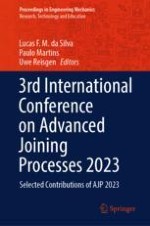2024 | Buch
3rd International Conference on Advanced Joining Processes 2023
Selected Contributions of AJP 2023
herausgegeben von: Lucas F. M. da Silva, Paulo Martins, Uwe Reisgen
Verlag: Springer Nature Switzerland
Buchreihe : Proceedings in Engineering Mechanics
